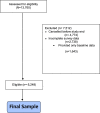Feasibility and acceptability of a novel telepsychiatry-delivered precision prescribing intervention for anxiety and depression
- PMID: 35854281
- PMCID: PMC9297585
- DOI: 10.1186/s12888-022-04113-9
Feasibility and acceptability of a novel telepsychiatry-delivered precision prescribing intervention for anxiety and depression
Abstract
Background: Major Depressive Disorder and Generalized Anxiety Disorder are pervasive and debilitating conditions, though treatment is often inaccessible and based on trial-and-error prescribing methods. The present observational study seeks to describe the use of a proprietary precision prescribing algorithm piloted during routine clinical practice as part of Brightside's telepsychiatry services. The primary aim is to determine the feasibility and acceptability of implementing this intervention. Secondary aims include exploring remission and symptom improvement rates.
Methods: Participants were adult patients enrolled in Brightside who completed at least 12 weeks of treatment for depression and/or anxiety and received a prescription for at least one psychiatric medication. A prescription recommendation was made by Brightside's algorithm at treatment onset and was utilized for clinical decision support. Participants received baseline screening surveys of the PHQ-9 and GAD-7, and at weeks 2,4,6,8,10 and 12. Intent-to-treat (ITT) sensitivity analyses were conducted. Feasibility of the implementation was measured by the platform's ability to enroll and engage participants in timely psychiatric care, as well as offer high touch-point treatment options. Acceptability was measured by patient responses to a 5-star satisfaction rating.
Results: Brightside accessed and treated 6248 patients from October 2018 to April 2021, treating a majority of patients within 4-days of enrollment. The average plan cost was $115/month. 89% of participants utilized Brightside's core medication plan at a cost of $95/month. 13.4% of patients in the study rated Brightside's services as highly satisfactory, averaging a 4.6-star rating. Furthermore, 90% of 6248 patients experienced a MCID in PHQ-9 or GAD-7 score. Remission rates were 75% (final PHQ-9 or GAD-7 score < 10) for the study sample and 59% for the ITT sample. 69.3% of Brightside patients were treated with the medication initially prescribed at intake.
Conclusions: Results suggest that the present intervention may be feasible and acceptable within the assessed population. Exploratory analyses suggest that Brightside's course of treatment, guided by precision recommendations, improved patients' symptoms of anxiety and depression.
Keywords: Anxiety; Depression; Mental health; Psychiatry; Telemedicine.
© 2022. The Author(s).
Conflict of interest statement
Dr. O’Callaghan, Dr. Belanger, Mr. Sullivan and Dr. Winsberg all hold stock in Brightside Health Inc. Dr. O’Callaghan, Mr. Sullivan, Ms. Gupta, Dr. Belanger, and Dr. Winsberg are all employees of Brightside Health, Inc. As such, the funding body took part in the design of the study and collection, analysis, and interpretation of data, and the writing of the manuscript. All participants in this study received psychiatric healthcare at Brightside Health Inc., a mental healthcare company. All authors of the submitted manuscript are employees of Brightside Health.
Figures
Similar articles
-
Testing the Feasibility, Acceptability, and Potential Efficacy of an Innovative Digital Mental Health Care Delivery Model Designed to Increase Access to Care: Open Trial of the Digital Clinic.JMIR Ment Health. 2025 Jan 29;12:e65222. doi: 10.2196/65222. JMIR Ment Health. 2025. PMID: 39879612 Free PMC article.
-
Evaluating Clinical Outcomes in Patients Being Treated Exclusively via Telepsychiatry: Retrospective Data Analysis.JMIR Form Res. 2023 Dec 8;7:e53293. doi: 10.2196/53293. JMIR Form Res. 2023. PMID: 37991899 Free PMC article.
-
Effects of COVID-19 on Patients in Adult Ambulatory Psychiatry: Using Patient-Rated Outcome Measures and Telemedicine.Telemed J E Health. 2022 Oct;28(10):1421-1430. doi: 10.1089/tmj.2021.0642. Epub 2022 Feb 14. Telemed J E Health. 2022. PMID: 35167369 Free PMC article.
-
Telephone interventions for symptom management in adults with cancer.Cochrane Database Syst Rev. 2020 Jun 2;6(6):CD007568. doi: 10.1002/14651858.CD007568.pub2. Cochrane Database Syst Rev. 2020. PMID: 32483832 Free PMC article.
-
A Systematic Review of the Use of Telepsychiatry in Depression.Community Ment Health J. 2021 Jan;57(1):93-100. doi: 10.1007/s10597-020-00724-2. Epub 2020 Oct 10. Community Ment Health J. 2021. PMID: 33040191 Free PMC article.
Cited by
-
Factors Influencing the Health Care Utilization Among People With Depression and/or Anxiety Symptoms.J Am Psychiatr Nurses Assoc. 2024 Sep-Oct;30(5):858-867. doi: 10.1177/10783903231197655. Epub 2023 Sep 19. J Am Psychiatr Nurses Assoc. 2024. PMID: 37724452 Free PMC article.
-
Telehealth-Supported Decision-making Psychiatric Care for Suicidal Ideation: Longitudinal Observational Study.JMIR Form Res. 2022 Sep 30;6(9):e37746. doi: 10.2196/37746. JMIR Form Res. 2022. PMID: 36178727 Free PMC article.
-
Large Language Models Versus Expert Clinicians in Crisis Prediction Among Telemental Health Patients: Comparative Study.JMIR Ment Health. 2024 Aug 2;11:e58129. doi: 10.2196/58129. JMIR Ment Health. 2024. PMID: 38876484 Free PMC article.
-
Consumer Expectations and Attitudes About Psychotherapy: Survey Study.JMIR Form Res. 2023 Jun 8;7:e38696. doi: 10.2196/38696. JMIR Form Res. 2023. PMID: 37289494 Free PMC article.
References
-
- Anxiety and Depression Association of America . Facts and Statistics. 2021.
-
- National Institute of Mental Health . Major Depression. 2021.
Publication types
MeSH terms
LinkOut - more resources
Full Text Sources
Medical
Miscellaneous



